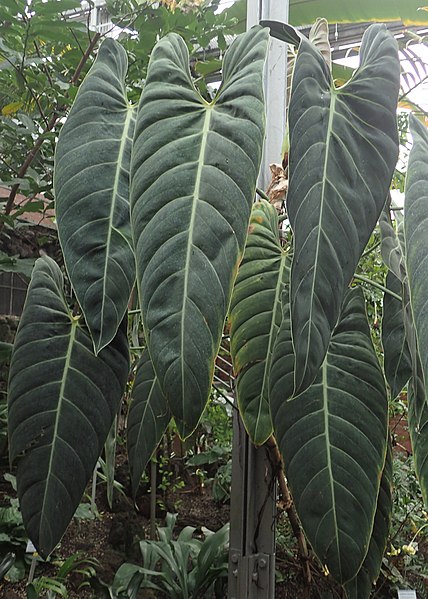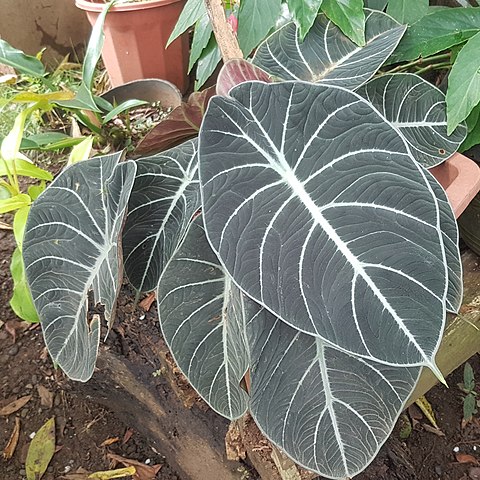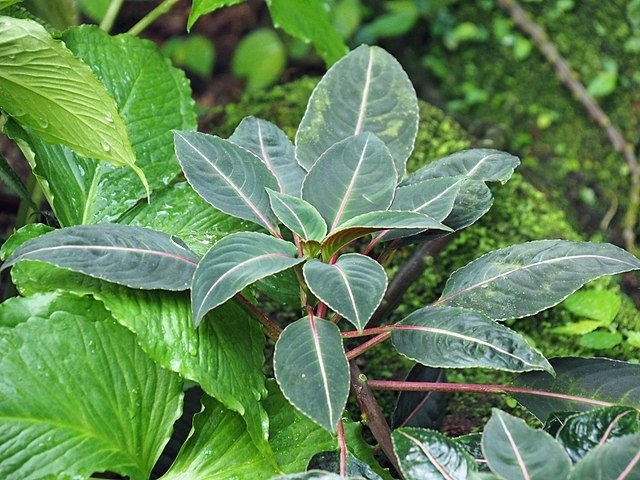10 Houseplants With Velvety Leaves
Are you looking for houseplants with velvety leaves? Here is a list of plants that have furry leaves and are commonly grown indoors.
The leaves of plants are impressive not only through their varied shapes, colors, and sizes but also through their texture. Whether rough, waxy, or covered with hair or thorns, every leaf is unique.
Today we are going to talk about several species of houseplants that have velvety leaves.
Contents
- 1. Gloxinia (Sinningia Speciosa)
- 2. African Violet (Saintpaulia Ionantha)
- 3. Purple Passion (Gynura Aurantiaca)
- 4. Panda Plant (Kalanchoe Tomentosa)
- 5. Black-gold Philodendron (Philodendron Melanochrysum)
- 6. Alocasia Black Velvet (Alocasia reginula)
- 7. Calathea Jungle Velvet (Goeppertia Warszewiczii)
- 8. Impatiens Morsei ‘Velvetea’
- 9. Felted Peperomia (Peperomia Incana)
- 10. Cobweb Spiderwort (Tradescantia Sillamontana)
1. Gloxinia (Sinningia Speciosa)
Gloxinia (Sinningia speciosa) is a popular houseplant in the family of Gesneriaceae. It is native to Brazil and is also commonly known under names like Brazilian gloxinia or florist’s gloxinia.
It does not grow very large and is ideal for small, bright rooms.

This plant is appreciated both for the beauty of its flowers and its foliage. It produces beautiful large bell-shaped flowers in red, pink, purple, or combined with white or yellow. Its leaves are green, velvety, large, oval-lanceolate, with toothed and wavy edges.
Sinningia speciosa is related to the African violet. It propagates easily through leaf cuttings and is not very hard to care for.
2. African Violet (Saintpaulia Ionantha)
African violet (Saintpaulia ionantha) is one of the most popular indoor plant species. It is native to Tanzania and Kenya.
This plant not only produces beautiful flowers from spring to late fall but also has an attractive foliage.

It is a small plant that does not take up much space. It has velvety leaves with wavy edges that grow in a rosette. They have a dark green color on the upper side and are brown on the lower side.
The flowers grow above the foliage and can be single or double and can have various colors such as pink, purple, white, blue, or speckled.
3. Purple Passion (Gynura Aurantiaca)
Purple passion (Gynura aurantiaca) is an evergreen flowering plant from the Asteraceae family, native to South Asia and frequently grown as an indoor plant in many regions of the world. It is also popularly known as the “velvet plant.”
It is habitually grown in pots as an indoor plant, but in warmer climates, Gynura Aurantiaca is often grown outside as an ornamental plant.

Purple passion has an accelerated growth rate and develops as a compact bush. Its leaves are large, with jagged edges, dark green in color but covered with purple hairs, which give them a velvety texture and a stunning color.
Although it produces flowers, purple passion is grown mainly for its foliage. Besides the fact that it blooms quite infrequently, its flowers also emit an unpleasant odor, so they are usually removed as soon as they start to form.
4. Panda Plant (Kalanchoe Tomentosa)
Panda plant (Kalanchoe tomentosa) is a slow-growing succulent plant in the botanical family of Crassulaceae, native to Madagascar.
Its leaves are thick and succulent, elongated, lance-shaped, grayish-green, and are covered with short and fine white-silvery hairs that give them a velvety feeling. Their edges are toothed and covered with dark brown spots.

Although it rarely blooms indoors, the panda plant produces yellowish-green and red flowers, also covered with bristles on the outside.
Many love this plant because it is relatively easy to care for and for its unique look offered by its fuzzy leaves. If you are not familiar with this species, you might even believe that it’s an artificial plant.
It is a slow-growing plant but can reach heights of up to 40 inches (1m) in optimal conditions.
5. Black-gold Philodendron (Philodendron Melanochrysum)
Black-gold philodendron (Philodendron melanochrysum) is a rare species of Philodendron indigenous to the tropical forests of Colombia and Costa Rica.
The black-gold philodendron has velvety foliage. The leaves are large and heart-shaped. The young leaves have a pinkish-red color, then turn deep dark green at maturity. They present pale green veins on their surface which give them a very attractive and exotic look.

Under optimal conditions, this plant can grow quite large even as a houseplant. It also likes to climb and will need a trellis or a support to hang on to.
Although it is not grown for its flowers, you may see mature plants blooming occasionally. Their flowers are not astonishing and most growers even remove them to direct the nutrients and energy to the growth of the leaves.
6. Alocasia Black Velvet (Alocasia reginula)
Alocasia black velvet (Alocasia reginula) is a species of tropical plants in the family Araceae, commonly grown as a houseplant. It is indigenous to Sabah, a state in northern Borneo, Malaysia.
This plant has large and velvety leaves. The color of the uppersides is dark green to almost black and with prominent silvery-white veins. The undersides have a reddish color with light green venation.

While it is a flowering plant, Alocasia reginula doesn’t bloom often when kept as a houseplant. However, the flowers produced by this plant are not at all spectacular, and many even recommend cutting them so that the nutrients necessary for their development are used for the growth of the foliage.
Despite its large leaves, this species does not typically exceed 16 inches (40 cm) in height as a potted plant. Hence, it is sometimes regarded as a miniature Alocasia.
7. Calathea Jungle Velvet (Goeppertia Warszewiczii)
Calathea jungle velvet (Goeppertia warszewiczii) is a perennial plant in the Marantaceae family, native to the tropical forests of Costa Rica and Nicaragua.
This plant is commonly grown as a houseplant and is particularly appreciated for its beautiful foliage that can give any space an exotic feel.
Calathea Warscewiczii has velvety, patterned leaves with shades of dark and lighter green on the uppersides and maroon-colored undersides. They are oval in shape with a pointed tip and sometimes have slightly wavy margins.
Similar to the well-known prayer plant, the leaves of Calathea jungle velvet will curl in response to cold temperatures or air currents. However, not as much.
Calathea Warscewiczii produces white cone-like, white inflorescences. Although, this rarely happens when grown as an indoor plant.
8. Impatiens Morsei ‘Velvetea’
Impatiens Morsei is a rare evergreen perennial plant in the botanical family of Balsaminaceae. It is native to a single region of China and is grown as a houseplant in various regions of the world.
This plant is valued for its eye-catching foliage and lovely flowers. It is rarely found in plant stores, so you should consider yourself lucky if you own one.

Impatiens Morsei has velvety, dark green leaves with a pinkish-white mid-vein on the upper side and reddish undersides.
From spring to fall, it produces white flowers with orange spots, comparable in shape to those of some species of orchids.
Although it looks like a small tree, it does not reach impressive sizes, which makes it an excellent indoor plant. Most of the time it does not exceed 23 inches (60 cm) in height.
9. Felted Peperomia (Peperomia Incana)
Felted peperomia (Peperomia incana) is an evergreen perennial plant in the botanical family of Piperaceae and is endemic to several regions of Brazil.
This species is not as famous as other plants in the genus Peperomia, but its popularity as a houseplant is increasing. It is valued mostly for its evergreen foliage, as well as because it does not require a lot of space and too much care.

Felted peperomia has fleshy, heart-shaped leaves, with surfaces covered in dense, short, grayish-white hairs that give them a fuzzy look and texture, hence its common name.
It produces white, spike-like flowers that raise above the foliage of the plant.
10. Cobweb Spiderwort (Tradescantia Sillamontana)
Cobweb spiderwort (Tradescantia sillamontana) is a perennial evergreen plant native to dry regions of Mexico. It is also known under names like the “white velvet” or “white gossamer plant.”
It is usually used as an outside ornamental plant, but it is also grown as a potted plant.

Cobweb spiderwort has a very unique and distinctive look. All its parts are hairy, which led to its common names of “cobweb” or “white velvet” spiderwort.
The leaves are fleshy, ovate, and covered with a dense layer of grayish-white short hairs.
It produces three-petaled pinkish-purple flowers.
Final Word
These are only a few of the houseplants that have velvety leaves. Apart from these, there are many other species whose leaves, stems, or flowers are covered with fine hairs that give them a velvety texture.
Whether you have landed on this page with the desire to identify an unknown plant that possesses these characteristics or to find a new plant to add to your collection, we hope that the information presented has been helpful.


